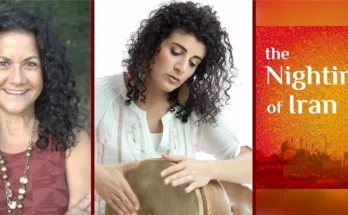Source: Iran International
 By Maryam Sinaiee
By Maryam Sinaiee

Iran’s state television is trying to overcome women’s unwillingness to vote in the March elections by changing its decades-long dress code for female presenters.
On Tuesday, Iran’s state broadcaster (IRIB) took an uncommon step by featuring a female presenter wearing an outfit that deviated from the traditional dress code enforced on women in Iran. This attire has historically subjected many Iranian women to various forms of trouble, including being denied entry into government buildings.
Zhila (Jila) Sadeghi who hosted a morning program wore a cream-colored, tailored jacket over a long, frilly black skirt and a patterned headscarf of red, gold and cream, and lots of make-up which made her look very much like hijab-wearing women in some other countries of the region, particularly Turkey and Lebanon. In the past, she had mostly appeared on air wearing a chador.
Most female presenters wear a long black veil (chador) over a lighter colored headscarf that tightly covers their hair and neck. Others wear a less condoned outfit consisting of a long coat (manteau), wide-legged trousers and a large headscarf coming down to the chest to disguise their figures as much as possible. Make-up, particularly lipstick, is not tolerated.

Sadeghi’s strikingly different attire, particularly given her reputation as a staunch regime advocate, made significant waves in Iranian media and social media. While the media in Tehran reported on IRIB’s new approach without extensive commentary, presumably due to concerns about censorship, it did not escape the notice of social media users.
On social media, many users interpreted this move as a hypocritical attempt to portray a more favorable image of the regime’s stance on hijab ahead of the elections, rather than a genuine shift in the regime’s approach to the issue. Some pointed out that over the past year, authorities in Iran have shuttered numerous businesses, confiscated many vehicles, and harassed thousands of women over hijab-related issues, leading to the tragic deaths of two young women, Mahsa (Jina) Amini and Armita Geravand, both of whom sustained fatal head injuries from hijab enforcers.
Ali Ahmadnia, journalist, pointed out on Twitter that not long ago a woman wearing the same kind of outfit would be detained by hijab police and accused of being “the enemy’s foot soldier who wants to undermine religious beliefs”. “But now there is a TV host wearing a jacket suit on air. What things we have not witnessed!” he tweeted.
However, some observers stressed that a television host does not have the autonomy to decide her on-air appearance, suggesting that Sadeghi’s attire must have been dictated or at least approved by individuals with significant decision-making authority within the organization or even the regime.
Iran is set to hold parliamentary and Assembly of Experts elections on March 1, with the latter responsible for appointing Supreme Leader Ali Khamenei’s successor. Authorities, including Khamenei, who have historically argued that high voter turnout is a testament to the regime’s legitimacy, appear to be deeply concerned about the possibility of very low turnout in the upcoming elections.
Polls conducted so far indicate that turnout may even be lower than the 2020 parliamentary elections and 2021 presidential elections, both of which set the lowest turnout records in the history of the Islamic Republic. Some estimates indicate a turnout as low as 10 percent.
Disillusioned with the regime’s claims of improving ordinary people’s lives, frustrated by the lack of social and political freedoms and vast corruption, as well as harsh treatment of critics and dissidents, many Iranians have made up their minds not to vote in any elections again because they don’t expect their votes to change anything.
In his recent speeches, Khamenei stressed the collective responsibility to mobilize the electorate.




